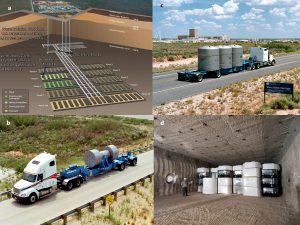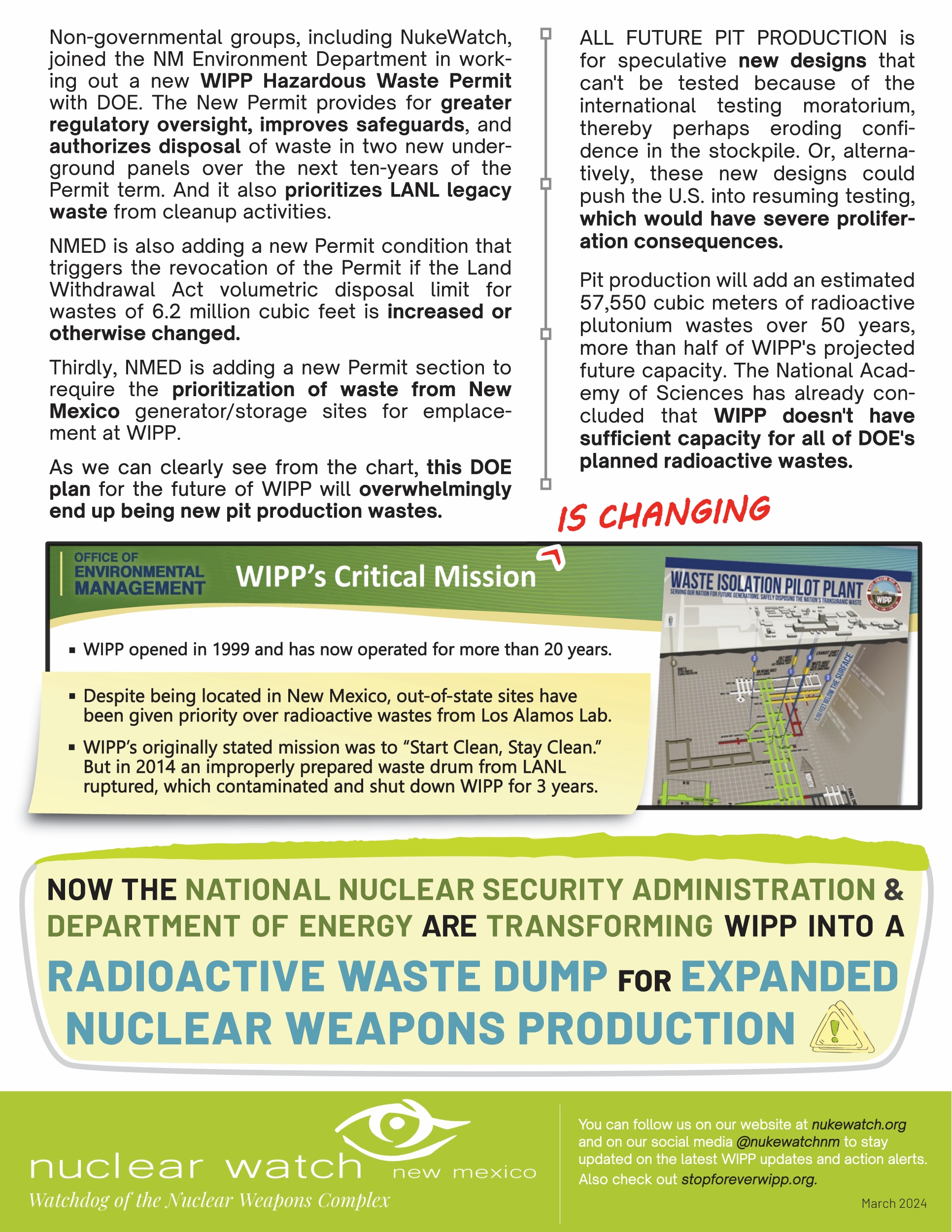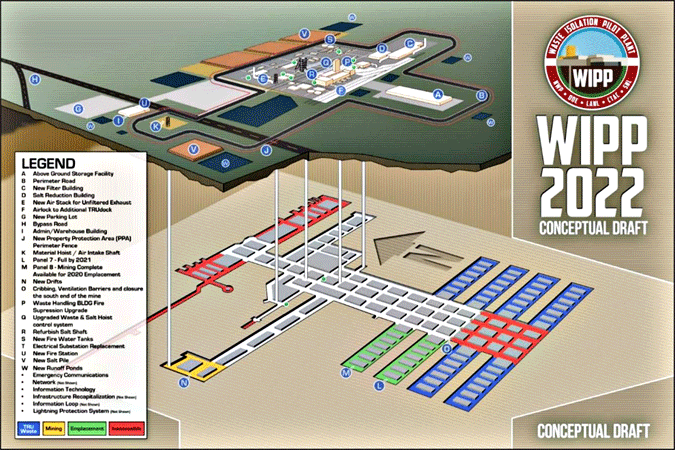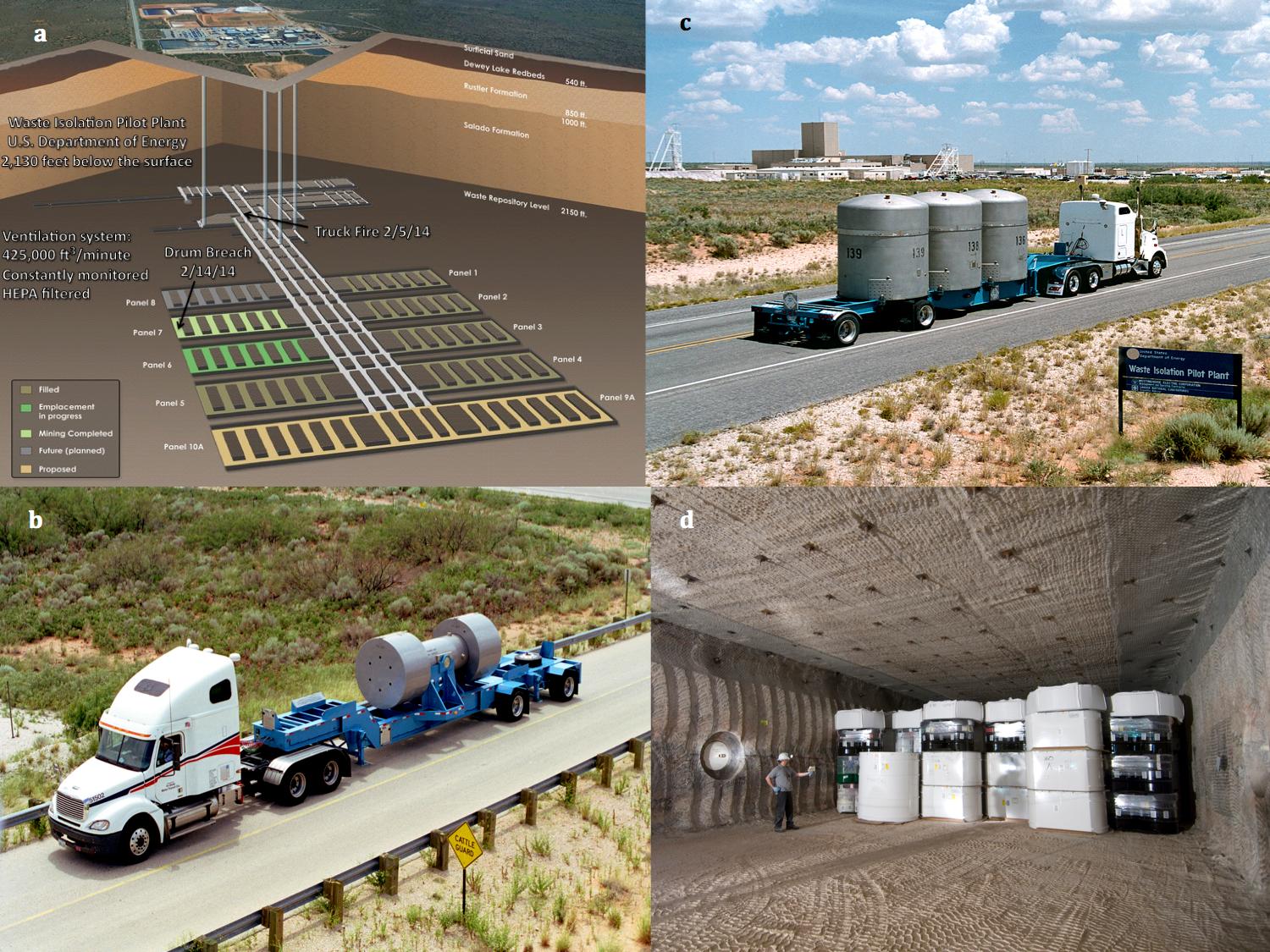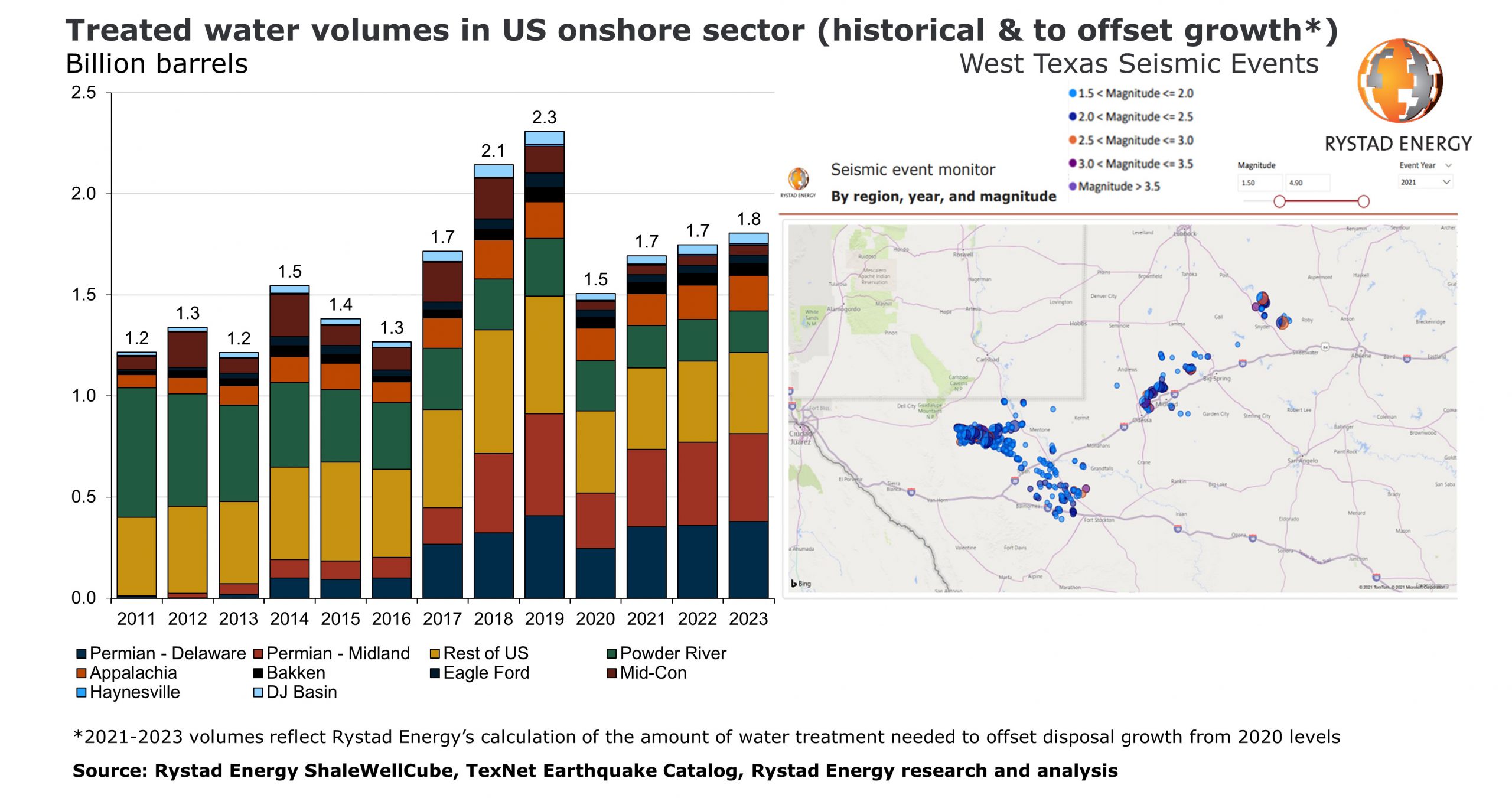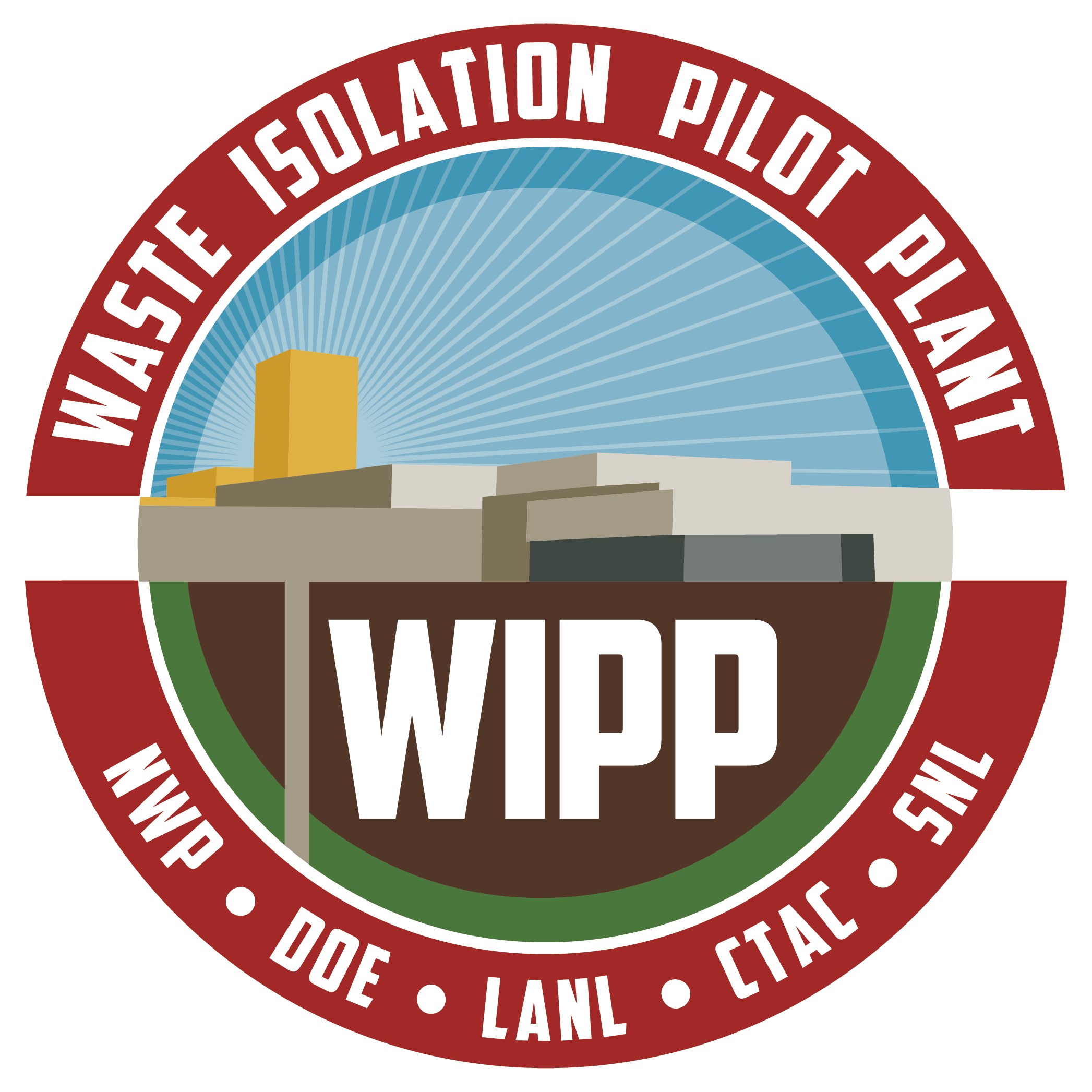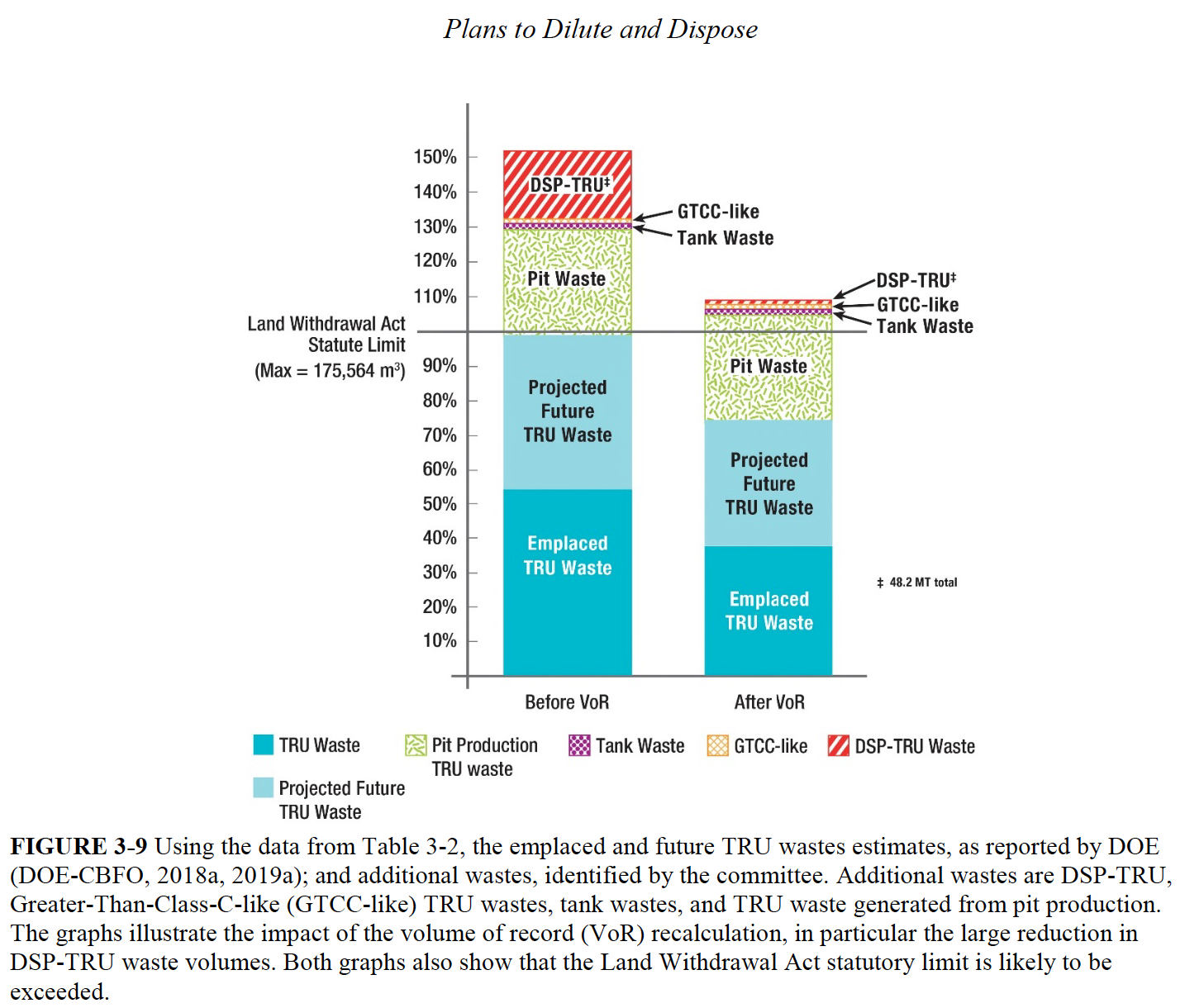Description and Current Mission
The Waste Isolation Pilot Plant (WIPP) is the nation's only deep geologic long-lived radioactive waste repository. Located 26 miles southeast of Carlsbad, New Mexico, the WIPP repository is mined within a 2,000-foot-thick bedded-salt formation. The Underground (U/G) is 2,150 feet beneath the ground surface. WIPP was constructed to determine the efficacy of an U/G repository for disposal of transuranic (TRU) waste. Disposal operations began in 1999 and are scheduled to continue for 35 years. WIPP was constructed for disposal of defense-generated TRU waste from DOE sites around the country. TRU waste consists of clothing, tools, rags, residues, debris, soil and other items contaminated with small amounts of plutonium and other man-made radioactive elements. The waste is permanently disposed of in rooms mined in an underground salt bed layer over 2000 feet from the surface.
TRU waste began accumulating in the 1940s with the beginning of the nation's nuclear defense program. As early as the 1950s, the National Academy of Sciences recommended deep disposal of long-lived TRU radioactive wastes in geologically stable formations, such as deep salt beds.
TRU waste is categorized as "contact-handled" or "remote-handled" based on the amount of radiation dose measured at the surface of the waste container. Contact-handled waste has a radiation dose rate not greater than 200 millirem (mrem) per hour, while remote-handled waste can have a dose rate up to 1,000 rem per hour. About 96 percent of the waste to be disposed at WIPP is contact-handled.
TRU waste is long-lived and has to be isolated to protect public health and the environment.
Four shafts connect the U/G area with the surface. The Waste Shaft headframe and hoist are located within the Waste Handling Building and are used to transport TRU mixed waste, equipment, and materials to the repository. The Waste Hoist can also be used to transport personnel and materials. The Air Intake Shaft (AIS) and the Salt Handling Shaft provide ventilation to all areas of the U/G except for the Waste Shaft station. This area is ventilated by the Waste Shaft itself. The Salt Handling Shaft is also used to hoist mined salt to the surface and serves as the principal personnel transport shaft. The Exhaust Shaft serves as a common exhaust air duct for all areas of the U/G.
History of WIPP
Throughout the 1960s, government scientists searched for an appropriate site for radioactive waste disposal, eventually testing a remote desert area of southeastern New Mexico where, 250 million years earlier, evaporation cycles of the ancient Permian Sea had left a 2,000-foot-thick salt bed.
DOE was authorized by Public Law 96-164, Department of Energy National Nuclear Security and Military Applications of Nuclear Energy Authorization Act of 1980, to provide a research and development facility for demonstrating the safe, permanent disposal of TRU wastes from national defense activities and programs of the United States exempted from regulations by the U.S. Nuclear Regulatory Commission.
Congress limited WIPP to the disposal of defense-generated TRU wastes in the 1992 Land Withdrawal Act. In 1998, the U.S. Environmental Protection Agency certified WIPP for safe, long-term disposal of TRU wastes.
On March 26, 1999, the first waste shipment arrived at WIPP from Los Alamos National Laboratory in New Mexico.
The WIPP Land Withdrawal Act, Public Law 102-579, as amended by Public Law 104-201, authorized the disposal of 6.2 million cubic feet of defense TRU waste at the WIPP facility.
The WIPP facility operates in several regulatory regimes. DOE has authority over the general operation of the facility, including radiological operations prior to closure. The U.S. Environmental Protection Agency (EPA), through 40 Code of Federal Regulations (CFR) Parts 191 and 194, certifies the long-term radiological performance of the repository over a 10,000-year compliance period after closure of the facility. The State of New Mexico, through EPA delegation of the Resource Conservation and Recovery Act (RCRA), has issued a Hazardous Waste Facility Permit for the disposal of the hazardous waste component of the TRU waste. Additionally, the Mine Safety and Health Administration (MSHA) is required to perform four inspections per year of WIPP.
WIPP's disposal rooms are nearly a half mile below the surface (2,150 feet). By comparison, the Empire State Building is only 1,454 feet high.
Browse this page to keep updated on NukeWatch and other local community group's efforts to STOP FOREVER WIPP
STAY INFORMED:
Endless Nuclear Waste Storage in NM?? Not On Our Watch…
Keep up with the Stop Forever WIPP Coalition to learn how to take action against the Federal Government’s Plan to Expand WIPP and keep it open indefinitely.
Visit the Stop Forever WIPP Coalition’s website and social media:
Website: www.StopForeverWIPP.org
Facebook: facebook.com/StopfvrWIPP
Twitter: twitter.com/stopforeverwipp
Instagram: instagram.com/stopfvrwipp
Stay Informed of All Permit-Related Happenings at WIPP! Sign Up for Updates:
The New Mexico Environment Department maintains a Facility Mailing List to which you can add your name and address to get the latest information – just email Ricardo Maestas at the New Mexico Environment Department at ricardo.maestas@state.nm.us and ask to be added to the list. Or mail your request with your mailing address to:
Continue reading→
WIPP News & Updates
Discovery of radioactive liquid pauses work at US nuke dump
“Independent federal investigators last month raised concerns about whether cost overruns and missed construction deadlines will continue at the Waste Isolation Pilot Plant…State regulators are weighing a permit change that some critics have said could lead to expanded repository operations. A decision is expected later this year.”
BY SUSAN MONTOYA BRYAN | April 11, 2022 AP NEWS apnews.com
ALBUQUERQUE, N.M. (AP) — An area at the U.S. government’s nuclear waste repository in southeastern New Mexico was evacuated over the weekend after workers handling a shipping container discovered a small amount of radioactive liquid inside it.
There was no indication of airborne contamination and testing of workers’ hands and feet turned up no contamination after the discovery was made late Saturday in a bay where containers are processed before being taken underground for disposal, officials said in a statement.
“The event at the site has been secured. There is no risk of radiological release and there is no risk to the public or the environment,” plant officials said their most recent statement, issued late Saturday.
Workers evacuated from area of Carlsbad nuclear waste repository after ‘abnormal event’
— DOE WIPP (@WIPPNEWS) April 10, 2022
— DOE WIPP (@WIPPNEWS) April 10, 2022
Officials at the facility say there was no risk of radioactive contamination.
BY ADRIAN HEDDEN | April 9, 2022 Carlsbad Current Argus currentargus.com
Carlsbad led to the evacuation of workers Saturday night from an area of the facility where waste is prepared for disposal.
The incident was reported at about 8:20 p.m. in the waste handling building, where shipments of nuclear waste are prepared for disposal in the underground repository.
Officials said there was no risk of a radiological release after the event was investigated.
As a drum of waste was being processed, liquid was found at the bottom of the container which tested positive for radioactive contamination, per a news release from WIPP officials.
All personnel in the area were evacuated and tested for contamination, and operations were temporarily paused.
Watchdog has concerns with projects at U.S. nuclear repository
“Nuclear watchdog groups have been critical of the Energy Department. They have raised concerns about the repository’s future, citing the increase in defense-related waste that will need to be disposed of when production of key components for the country’s nuclear arsenal ramps up at Los Alamos National Laboratory and the Savannah River Site in South Carolina.”
By Scott Wyland swyland@sfnewmexican.com | March 15, 2022 santafenewmexican.com
ALBUQUERQUE — There’s no way of knowing if cost increases and missed construction deadlines will continue at the only United States underground nuclear waste repository, according to a federal watchdog report made public Tuesday.
The Government Accountability Office outlined the concerns in its report, noting the U.S. Energy Department is not required to develop a corrective action plan for addressing the root causes of challenges at the Waste Isolation Pilot Plant in Southern New Mexico.
A multimillion-dollar project is underway at the underground facility to install a new ventilation system so full operations can resume after a radiation leak in 2014 forced the repository’s closure for nearly three years.
Waste Isolation Pilot Plant: Construction Challenges Highlight the Need for DOE to Address Root Causes
The new ventilation system at WIPP now estimated to take 4 more years and $200 million more dollars than original estimates.
NEW Report from the U.S. Government Accountability Office March 15, 2022 https://www.gao.gov/products/gao-22-105057
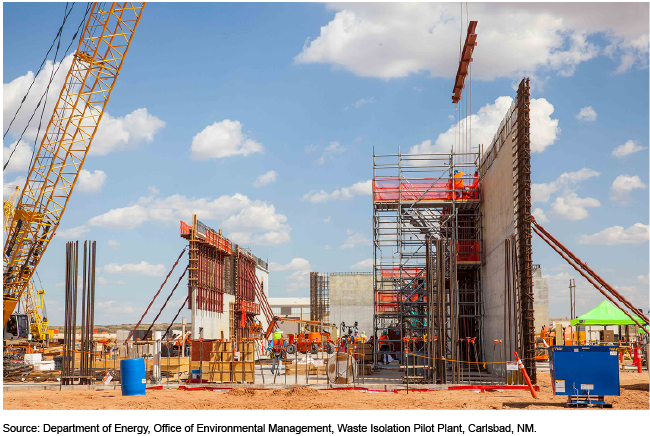 The Waste Isolation Pilot Plant (WIPP), near Carlsbad, New Mexico, is the nation’s only facility for disposal of certain defense-related nuclear waste. The Department of Energy (DOE) identified two root causes for cost increases and schedule delays in its project to install a new ventilation system at WIPP (see figure). The facility is currently operating at a reduced capacity because of ventilation issues in the underground waste disposal areas. The root causes DOE identified were (1) its contractor’s inexperience managing construction projects and (2) an inability to incentivize staff to work in Carlsbad. DOE also identified more specific problems with this ventilation project, and has taken corrective actions to address them. While some of these corrective actions may also help to address the root causes, the extent to which these actions will do so is unclear because DOE is not required to develop a corrective action plan for addressing the root causes and does not have a process to determine whether root causes have been sufficiently addressed. Without such a plan and process, DOE cannot ensure that root causes it identifies for cost increases and schedule delays in the WIPP ventilation project or other projects will not persist or recur.
The Waste Isolation Pilot Plant (WIPP), near Carlsbad, New Mexico, is the nation’s only facility for disposal of certain defense-related nuclear waste. The Department of Energy (DOE) identified two root causes for cost increases and schedule delays in its project to install a new ventilation system at WIPP (see figure). The facility is currently operating at a reduced capacity because of ventilation issues in the underground waste disposal areas. The root causes DOE identified were (1) its contractor’s inexperience managing construction projects and (2) an inability to incentivize staff to work in Carlsbad. DOE also identified more specific problems with this ventilation project, and has taken corrective actions to address them. While some of these corrective actions may also help to address the root causes, the extent to which these actions will do so is unclear because DOE is not required to develop a corrective action plan for addressing the root causes and does not have a process to determine whether root causes have been sufficiently addressed. Without such a plan and process, DOE cannot ensure that root causes it identifies for cost increases and schedule delays in the WIPP ventilation project or other projects will not persist or recur.
‘More than 1,000’ New Mexicans call State to oppose plutonium plan at nuclear waste site
PRESS CONFERENCE MAR. 1, 2022 - NEW MEXICANS SUPPORT GOVERNOR ACTING TO STOP WIPP EXPANSION
By Adrian Hedden Carlsbad Current-Argus March 4, 2022 currentargus.com
“New Mexico agreed to host WIPP after carefully crafting agreements that limit what the federal government can do with it. It was afraid that this very thing would happen, and DOE didn’t disappoint,” she said Tuesday during a press conference in Santa Fe.
“WIPP’s mission can only be changed if the DOE breaks every legal agreement that it made with New Mexico in order to get it to host the WIPP site in the first place.”
Also concerning, Weehler said, was the transportation plan to ultimately bring the plutonium to WIPP.
Mostly originating at the Pantex Plant near Amarillo, Texas, the waste would first travel to Los Alamos National Laboratory (LAN) in northern New Mexico via truck for processing.
Why You Should Care about the Expanding WIPP Mission
Cindy Weehler gave a powerful speech during the March 1, 2022 press conference at the New Mexico Capitol about why you should care about the expanding mission for the Waste Isolation Pilot Plant (WIPP). People are opposing the Department of Energy (DOE) WIPP expansion plans that violate the law. We provide Weehler’s speech below.
Weehler is Co-Chair of 285 ALL, a neighborhood issues awareness group based south of Interstate 25. Before the press conference, she presented over 1,100 petition signatures to the Governor’s Office. The petition reads:
Petition to Governor Michelle Lujan Grisham
New Mexicans call on Governor Michelle Lujan Grisham to stand up for public health and the environment by stopping the expansion of the nuclear waste facility called the Waste Isolation Pilot Plant (WIPP) in southeastern New Mexico.
New Mexicans oppose the nuclear waste expansion at WIPP because:
- The federal government’ plans would transport more nuclear weapons waste to WIPP than is allowed.*
- The plutonium nuclear waste in the WIPP expansion is still dangerous for hundreds of thousands of years and endangers the health of our families and future generations.
- Unless New Mexico says ‘NO’ to WIPP expansion, other disposal locations will not be developed, and WIPP and NM will always be the only dump site, which is not fair. New Mexico never agreed to bear the burden of being the only nuclear waste dump site in the country.
- The federal government has not been transparent about its WIPP expansion plans, and has repeatedly refused to discuss the plans publicly, including in hearings on the WIPP Permit. Many New Mexicans are not even aware of those plans. We deserve a transparent and fair process that includes the voices of all impacted communities.
We strongly support, and urge our Governor to take all necessary actions, including denying permits for the piecemeal expansion.
New Mexico governor asked to stand up to more nuclear waste
“This citizen petition highlights the frustration of New Mexicans with DOE’s Environmental Management program. We fully expect the Department of Energy to meaningfully engage with stakeholders in New Mexico communities on this issue.” – Nora Meyers Sackett, governor spokeswoman.
By SUSAN MONTOYA BRYAN | AP NEWS March 1, 2022 apnews.com
ALBUQUERQUE, N.M. (AP) — A coalition of environmentalists and nuclear watchdogs on Tuesday delivered more than 1,000 petition signatures to Democratic Gov. Michelle Lujan Grisham asking her to take all steps necessary to stop any expansion of the federal government’s nuclear repository in southeastern New Mexico.
Dozens of people gathered at the state Capitol because they are concerned about the potential for the Waste Isolation Pilot Plant to be a disposal site for diluted plutonium.
They said the dump was never intended for that type of radioactive waste.
Waste Isolation Pilot Plant leadership expect nuclear waste site to be open until 2050
The U.S. National Nuclear Security Administration claims that a little more than half of WIPP’s future capacity will be reserved for future plutonium pit bomb core production. Further, those new radioactive wastes would be given priority over existing legacy cleanup wastes.
To quote:
“The combined TRU waste (1,151 m3) generated over 50 years would be 57,550 m3, which would account for 53 percent of the projected available capacity at WIPP. In addition, use of WIPP capacity for national security missions such as pit production would be given priority in the allocation process.”
DOE/EIS-0236-S4-SA-02, December 2019, Final Supplement Analysis of the Complex Transformation Supplemental Programmatic Environmental Impact Statement, p. 65, https://www.energy.gov/sites/prod/files/2020/01/f70/final-supplement-analysis-eis-0236-s4-sa-02-complex-transformation-12-2019.pdf
Courtesy of WIPPNUCLEAR WATCH NEW MEXICO IS OPPOSED TO THE STATE OF NEW MEXICO BEING THE NATION’S LARGEST PLUTONIUM WASTE PRODUCER AS WELL AS THE NATION’S ONLY PLUTONIUM WASTE DUMP.
BY: Adrian Hedden Carlsbad Current-Argus | February 25, 2022
Nuclear waste will continue being buried at a facility near Carlsbad for the coming decades, as far into the future as 2050 or 2080.
In preparation for that continued mission of disposing of the nation’s transuranic (TRU) waste – mostly clothing materials and equipment irradiated during nuclear activities – the Waste Isolation Pilot Plant saw myriad projects at the site aimed at increasing airflow and ensuring enough space is available for the waste.
COVID-19 an obstacle for nuclear waste disposal at Waste Isolation Pilot Plant, officials say
Officials plan to ramp up operations as pandemic hoped to subside
“With continued increases in shipments, WIPP officials said they hoped to fill the seventh disposal panel by the middle of 2022, planning to begin emplacing waste in the eighth and final panel as mining the area was completed last year.”
By Adrian Hedden Carlsbad Current-Argus January 31, 2022 currentargus.com
Waste Isolation Pilot Plant struggles to control costs, per annual performance evaluation
“Conducted by the DOE’s Carlsbad Field Office (CBFO), the evaluation called for improvements in cost control, schedule and risk management, along with work planning and control processes.”
By Adrian Hedden Carlsbad Current-Argus January 12, 2022 currentargus.com
Lingering struggles to complete construction projects on schedule while controlling costs at the Waste Isolation Pilot Plant factored into the U.S. Department of Energy’s annual fee allotment to primary contractor Nuclear Waste Partnership (NWP).
NWP earned 67 percent of its potential, performance-based fee – about $10.9 million of about $16.2 million available to the contractor in Fiscal Year 2021.
About $7.6 million of the fee was awarded for specific task incentives with $10.9 million available, and the other $3.3 million came from the subjective portion of the evaluation from a total offering of $5.3 million.
Energy Department to spend $15.5M to upgrade route from Los Alamos lab to waste site [WIPP]
“Essentially blessing what DOE was going to have to do anyway in order to expand nuclear weapons activities and waste disposal,” said Jay Coghlan, executive director of Nuclear Watch New Mexico. “And once again demonstrated the subservience of our state government to the nuclear weapons industry here in New Mexico.”
By Scott Wyland swyland@sfnewmexican.com Santa Fe New Mexican December 6, 2021 santafenewmexican.com
The N.M. 4 and East Jemez Road intersection in the far northwestern corner of Santa Fe County will be improved as part of a $15.5 million upgrade of routes on which Los Alamos National Laboratory transports nuclear waste to an underground disposal site in Southern New Mexico.
The U.S. Energy Department will spend $3.5 million to improve the intersection, which lies just outside Los Alamos County, and another $12 million to upgrade routes it owns and uses mostly to ship transuranic waste — contaminated gloves, clothing, equipment, soil and other items — to the Waste Isolation Pilot Plant near Carlsbad.
Risk of quakes caused by oil, gas in New Mexico rising
“The occurrence of smaller earthquakes began to increase in 2017, when oil and gas boomed in the region, up to about three per day recently. In 2021, records show the region was on track for more than 1,200 earthquakes with magnitudes of 1 to 4.”
CARLSBAD, N.M. (AP) — Multiple earthquakes were felt earlier this fall in West Texas, leading regulators in that state to designate a seismic response area and call for less wastewater from oil and gas development to be injected in disposal wells.
As more seismic activity was reported closer to the state line, officials in New Mexico have been watching closely and gathering data. Some officials are concerned that as Texas limits the injection of produced water as a means to curb the seismic activity, that could affect producers in New Mexico.
WIPP: Judge upholds change in how nuke waste is counted. Could keep site open to 2050
“We know it’s part of expanding WIPP. We know what DOE is doing but DOE doesn’t want to publicly admit it and the Environment Department doesn’t want to deal with it…The reason the laws have always put limits on WIPP is that the DOE was supposed to be finding locations for other repositories. There is no other repository and that’s why they don’t want to have a limit on what goes into WIPP.” — Don Hancock, nuclear waste program director at Southwest Research and Information Center.
By Adrian Hedden Carlsbad Current-Argus November 15, 2021 currentargus.com
A New Mexico appellate judge upheld a change in how the volume of nuclear waste disposed of at the Waste Isolation Pilot Plant is counted, shifting the repository from being halfway to capacity to only a third full.
In 2018, the U.S. Department of Energy requested to modify its WIPP operating permit with the New Mexico Environment Department (NMED) to change how it counts the amount of waste toward the facility’s statutory limit of 6.2 million cubic feet of transuranic (TRU) waste consisting of clothing materials and equipment irradiated during nuclear activities.
The change was intended to count the inner volume of the waste as opposed to the volume of the outer containers that hold the waste, seeking to avoid counting air between the waste itself and waste drums.
NMED approved the permit modification request (PMR) in 2019, but Albuquerque-based watchdog groups Southwest Research and Information Center and Nuclear Watch New Mexico immediately appealed the decision.
Proposed plutonium shipments concern New Mexico lawmakers
“The agency has said little overall about its plans, despite the potential hazards, said Cindy Weehler, who co-chairs the watchdog group 285 ALL.”
By Scott Wyland swyland@sfnewmexican.com Santa Fe New Mexican santafenewmexican.com

A panel of state lawmakers expressed concerns Friday about plans to truck plutonium shipments through New Mexico, including Santa Fe’s southern edge, and will send letters to state and federal officials asking for more information on the transports.
Two opponents of the shipments — a Santa Fe County commissioner and a local activist — presented the Department of Energy’s basic plan to the Legislature’s Radioactive and Hazardous Materials Committee, provoking a mixture of surprise and curiosity from members.
Several lawmakers agreed transporting plutonium is more hazardous because it is far more radioactive than the transuranic waste — contaminated gloves, equipment, clothing, soil and other materials — that Los Alamos National Laboratory now ships to the Waste Isolation Pilot Plant, an underground disposal site near Carlsbad.
WIPP Shipments Stopped Due to Maintenance Problems at Site
Joni Arends, of CCNS, said, “As early as November 2013, Nuclear Waste Partnership, LLC, began to physically expand the WIPP underground. The fire and explosion shutdown that work. It remains evident that NWP is more interested in doubling the size of the WIPP underground and keeping it open forever than doing preventive maintenance.”
CONCERNED CITIZENS FOR NUCLEAR SAFETY October 23, 2021
Due to on-going maintenance problems in the underground disposal facility, the Waste Isolation Pilot Plant (WIPP) requested an extension of time from the New Mexico Environment Department to store waste in the Waste Handling Building. https://wipp.energy.gov/
The request for a 45-day extension to store 13 shipments of plutonium- contaminated waste comes on the heels of on-going maintenance problems at WIPP [PDF]. On October 14th, 2021, the Environment Department approved the extension to November 30th, 2021 [PDF]. All waste shipments to WIPP had previously been stopped from August 25th until September 30th.
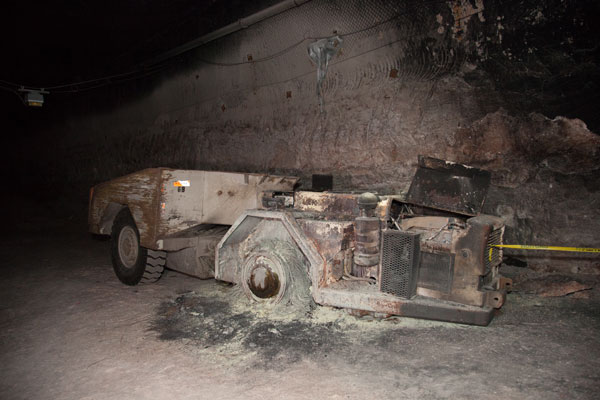
Maintenance problems include ventilation problems on the surface in the Waste Handling Building and managing the floors in the underground. The salt can heave and create uneven surfaces where waste is transported for disposal.
Nuclear waste facility near Carlsbad sees COVID-19 surge as infections rise in New Mexico
COVID-19 infections resurged at the Waste Isolation Pilot Plant in recent weeks as cases of the virus climbed in the communities surrounding the nuclear waste repository in southeast New Mexico.
There were 14 positive cases among workers at the site or associated with the facility reported between Aug. 17 and 31, per the latest report from Nuclear Waste Partnership (NWP) – WIPP’s primary operations contractor.
In total, WIPP reported as of Aug. 31, there were 25 active cases.
WIPP officials did not report the identities of patients or companies where the infected workers were employed.
All employees at WIPP were encouraged to receive a COVID-19 vaccination, per an NWP news release, and required to wear protective face masks when indoors, vaccinated or not, and social distance when possible.
Waste Isolation Pilot Plant needs more space to dispose of nuclear waste, officials say
“..A 10-year renewal of the permit itself was underway after expiring last year and Don Hancock, nuclear waste program manager at watchdog group Southwest Research and Information Center said any modifications to the permit should be included in the full renewal or wait until after its approval.
He said the DOE aimed to “piecemeal” an expansion of WIPP operations and its lifetime to avoid a discussion on broadening the facility’s purpose and keeping it operational indefinitely.
The current permit called for WIPP to be closed by 2024, but officials speculated it could take as long as until 2050 to complete its mission.”
BY: Adrian Hedden Carlsbad Current-Argus
More underground space is needed to complete the mission at the Waste Isolation Pilot Plant to dispose of nuclear waste, contend WIPP officials during a Monday public meeting.
The U.S. Department of Energy was underway with a permit modification request (PMR) that would amend the DOE’s permit with the State of New Mexico to allow for the mining of two new panels where waste would be disposed of along with drifts connecting the panels to the rest of the underground repository.
At WIPP, transuranic (TRU) nuclear waste consisting of clothing items and equipment irradiated during nuclear activities at DOE sites across the country is disposed of via burying in an underground salt deposit.
To achieve this, panels consisting of seven rooms each are mined about 2,000 feet underground where drums of the waste are emplaced, and the salt gradually collapses to permanently entomb the waste.
But due maintenance issues and a three-year shutdown of underground operations in 2014 following an accidental radiological release, portions of three of panels were left unusable and the DOE hoped to mine new panels to finishing burying the waste.
NNSA Los Alamos Shipments to WIPP Resume
BY: WAYNE BARBER
Shipments of transuranic waste to the Waste Isolation Pilot Plant from National Nuclear Security Administration operations at the Los Alamos National Laboratory in New Mexico were set to resume this week after being on hold since an ignition scare in February,…
Rep. Chris Chandler and NMED Sec. James Kenney Unhappy With Progress Of Waste Shipment From LANL
“The poor performance at LANL I think is exactly why we sued the Department of Energy because we believe the DOE and contractor are in violation of the Consent Order, we need to correct that and from a policy perspective, the Department of Energy has prioritized over New Mexico, cleanup at Savannah River, cleanup at Idaho National Labs, cleanup at all these other places and that is unacceptable to the state of New Mexico since we are the only state that holds the geologic repository known as WIPP,” – New Mexico Environment Department Secretary James Kenney
BY MAIRE O’NEILL maire@losalamosreporter.com | The Los Alamos Reporter June 8, 2021
District 43 Rep. Christine Chandler and New Mexico Environment Department Secretary James Kenney on Monday both criticized the Department of Energy’s lack of progress in shipping waste from Los Alamos National Laboratory to the Waste Isolation Pilot Project (WIPP) in Carlsbad. Their comments were made during the Legislative Radioactive & Hazardous Materials Committee meeting. Chandler is the vice chair of that committee.
Eletha Trujillo, Bureau Chief of the Hazardous Waste Planning Division at the state Energy, Minerals and National Resources Department, earlier in the meeting noted that there are two groups from LANL that ship waste – the DOE Environmental Management group and the DOE National Security Administration group.
“The DOE NNSA group had some safety violations back in February – the spark incident that occurred with a barrel at Los Alamos and so they have not been able to do any shipments. They do have material, but they’re not able to ship anything because they’re under a safety hold by the NRC. When they complete their plan and they get approval again from the NRC then the NNSA will be able to ship again. We don’t know when that’s going to happen. Typically the NNSA tends to have more safety violations than Environmental Management,” Trujillo said.
She added that EM has shipped their material and does not have enough material for a full load.
New company sought to operate Waste Isolation Pilot Plant under $3 billion contract
Little change to workforce, operations expected
Adrian Hedden Carlsbad Current-Argus |
A new primary contractor could be coming to the Waste Isolation Pilot Plant as the U.S. Department of Energy sought bids from prospective contractors for the management and operations of the nuclear waste site near Carlsbad.
The current holder of the contract Nuclear Waste Partnership began its work at WIPP in 2012 and its contract will expire in September 2021, with an extension carrying the contract through September 2022.
At that point, Vice President of Marketing and Communications at Amentum – NWP’s parent company – Keith Wood said the contractor’s lifetime would end.
“NWP was established to perform the current mission for the current contract,” Wood said. “That company will not be bidding on the next contract. Their sole mission was to perform the work under the current contract.”
Wood declined to comment on if any Amentum-led subsidiaries would bid on the new contract to operate WIPP.
The four-year contract will include six, one-year extension options and was valued at $3 billion over a 10-year performance period.
Department of Energy seeks to modify N.M. plant’s nuclear waste permit
Dragging out WIPP’s operations decades past the original 20-year agreement violates the social contract made with New Mexicans, said Scott Kovac, research and operations director for the nonprofit Nuclear Watch New Mexico.
WIPP is being equipped to take the waste that will be generated from production of plutonium pits for nuclear warheads, Kovac said.
“It [WIPP] was never really suppose to do that,” Kovac said.
Scott Wyland swyland@sfnewmexican.com | Santa Fe New Mexican May 17, 2021
Federal officials say a new air shaft is needed at the nuclear waste disposal site in Southern New Mexico to keep workers safe and run more efficiently.
Watch this video from the Stop Forever WIPP coalition: “When is a shaft more than a shaft?” dispelling the idea that an expansion of WIPP will mostly impact the South Eastern part of New Mexico; The new waste targeted for WIPP would be re-processed at Los Alamos. It also dispels the idea that targeting NM for waste disposal has nothing to do with our minority majority population.
WIPP completes maintenance outage, intends to up shipments of nuclear waste post-pandemic
Reinhard Knerr, manager of the U.S. Department of Energy’s Carlsbad Field Office said WIPP will resume accepting shipments of low-level transuranic waste from DOE sites around the country and will continue to emplace the waste for final disposal in WIPP’s underground mine.
By: Adrian Hedden | currentargus.com April 26, 2021
Shipments and disposal of nuclear waste resumed at the Waste Isolation Pilot Plant after a two-month pause in the repository’s primary operations to allow personnel to complete several maintenance projects underground and on the surface.
WIPP completed 97 projects during the maintenance outage which ran from Feb. 15 to April 15, upgrading infrastructure throughout the facility.
The work involved mine operations, waste handling, hoisting, ground control, safety and engineering, and the break included a site-wide power outage to allow electrical work to be completed safely.
Waste Isolation Pilot Plant aims to expand underground facility to hold nuclear waste
“WIPP is supposed to be limited. The state did not agree to 12 panels.”
By: Adrian Hedden | currentargus.com April 15, 2021
A plan to build two new areas to dispose of nuclear waste began taking shape at the Waste Isolation Pilot Plant after the U.S. Department of Energy published a report on the feasibility of adding an 11th and 12th waste panel to the underground nuclear waste repository.
DOE Planning to Increase Down-Blended Plutonium Shipments to Waste Isolation Pilot Plant
Savannah River Site is the third largest shipper of waste to WIPP, with 1,679 as of April 3, per the latest records from WIPP.
By: Adrian Hedden | currentargus.com April 7, 2021
Federal nuclear waste managers are planning to ramp up shipments of plutonium from a site in South Carolina for final disposal at the Waste Isolation Pilot Plant in southeast New Mexico.
The U.S. Department of Energy’s (DOE) Office of Environmental Management (EM) began preparing equipment at the Savannah River Site (SRS) in Aiken, South Carolina used to package and inspect drums of the waste before shipping to WIPP where it will be permanently disposed of in the repository’s underground salt formation.
The plutonium waste will be inspected to verify that it meets the criteria required for emplacement at WIPP, which is used to dispose of low-level transuranic (TRU) nuclear waste – mostly clothing items and equipment radiated during nuclear activities.
‘Sparking’ nuclear waste drum at Los Alamos National Lab leads to evacuation at WIPP
“A sparking drum of nuclear waste at Los Alamos National Laboratory (LANL) led to a temporary evacuation of a section of the Waste Isolation Pilot Plant’s underground repository as officials investigated if any other drums of waste emplaced at WIPP posed a similar threat.”
By: Adrian Hedden, Carlsbad Current-Argus March 31, 2021
Investigators later found no one was hurt and no radiation was released, according to a March 12 letter from the lab to the New Mexico Environment Department (NMED) Hazardous Waste Bureau.
The lab reported it happened as workers packed a drum of low-level transuranic (TRU) waste on Feb. 26 for delivery and disposal at WIPP.
TRU waste is equipment, clothing materials and other items radiated during nuclear activities.
During the packing process, two high efficiency particulate air (HEPA) filters were placed into a drum, followed by a “metal waste item,” read the letter from the lab.
The item tore the bag containing the HEPA filters, and sparks were observed coming out of the container when the item contacted the filters.
Checking in: WIPP maintenance work ‘on schedule’ during 2-month operations pause
At WIPP, the waste is delivered from facilities operated by the U.S. Department of Energy around the country and buried in an underground salt deposit which gradually collapses and encases the waste permanently.
By: Adrian Hedden | currentargus.com March 15, 2021
The Waste Isolation Pilot Plant halted waste emplacement and handling operations for the last month at the nuclear waste repository near Carlsbad while an array of maintenance projects was completed.
The facility, which permanently disposes of low-level transuranic (TRU) nuclear waste about 2,000 feet underground, planned the outage for about two months until April 14 to allow workers to complete routine upgrades to its infrastructure and other needed work.
During the two-month pause, WIPP planned on 97 activities from six departments including mine operations, waste handling, hoisting, work control, safety and engineering.
Staffing, scheduling problems imperil projects at Waste Isolation Pilot Plant, report says
Within the report, the GAO pointed to “significant” staffing shortages at WIPP that could prevent WIPP from completing construction projects needed to increase the facility’s space for waste disposal and allow for more workers in the underground to mine and emplace waste simultaneously.
By: Adrian Hedden | currentargus.com March 11, 2021
Staffing and other problems at the Waste Isolation Pilot Plant continued to be voiced by the federal government’s watchdog agency in a two-year report seeking to identify struggling areas in the government and ways to improve operations.
The Government Accountability Office (GAO) identified the U.S. Department of Energy’s contract and project management at both the National Nuclear Security Administration (NNSA) and the Office of Environmental Management (EM) as one of six areas in its 2021 “High Risk List” that had showed some improvement since the last such report in 2019.
The EM manages WIPP on a federal level as low-level nuclear waste is permanently disposed of in an underground salt bed at the facility near Carlsbad.
Plan to send diluted plutonium to Waste Isolation Pilot Plant moves forward
A plan to dispose of surplus plutonium at the Waste Isolation Pilot Plant through a dilution process that would reduce the waste to radiation levels allowable at the facility moved forward at the end of 2020 and the process was expected to continue through 2022.
By: Adrian Hedden | currentargus.com February 8, 2021
The National Nuclear Security Administration (NNSA) – an arm of the U.S. Department of Energy – announced in December its intention to draft an environmental impact statement on the project and a public comment scoping was extended until Feb. 18.
Comments on the project can be made to the NNSA via email to SPDP-EIS@NNSA.DOE.GOV with the subject line SPDP EIS Scoping Comment.
The EIS will study the scope of the project and its potential impacts on the environment and DOE operations at numerous sites involved in the storage, down-blending and final disposal of the plutonium.
WIPP: New Mexico regulators halt utility shaft project, cite COVID-19, planning problems
“Given the current high incidence rate at the WIPP facility, including a reported death of an employee, the circumstances of which are currently unknown, it is clear that the Permittees are unable to successfully mitigate COVID-19 risk to protect human health while conducting the activities under the scope of this Request,” the letter said.
BY: Adrian Hedden, Carlsbad Current-Argus, N.M.| currentargus.com
Construction of a $100 million utility shaft at the Waste Isolation Pilot Plant could be halted after the New Mexico Environment Department denied a request to extend state authorization to build the shaft, citing missed deadlines in the planning of the project and the continued spread in COVID-19 cases at the facility.
The shaft, part of an almost $300 million rebuild of WIPP’s ventilation system, along with a series of fans and filter buildings known as the Safety Significant Confinement Ventilation System (SSCVS), was intended to improve airflow in the WIPP underground and allow for waste emplacement and mining to occur simultaneously along with future expansions of the nuclear waste repository.
STOP FOREVER WIPP! Specific News to WIPP Closing Plans
Nothing Found
It seems we can’t find what you’re looking for. Perhaps searching can help.
Video Presentation on WIPP Expansion - February 5, 2022
Resources & Media
National Academy of Scientists Report
Review of the Department of Energy's Plans for Disposal of Surplus Plutonium in the Waste Isolation Pilot Plant 2020
Action Alerts
Nothing Found
It seems we can’t find what you’re looking for. Perhaps searching can help.
Quotes
Nothing Found
It seems we can’t find what you’re looking for. Perhaps searching can help.

